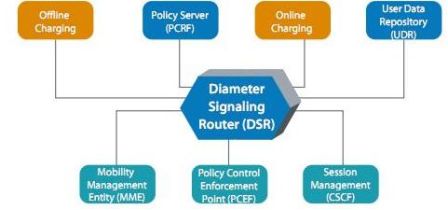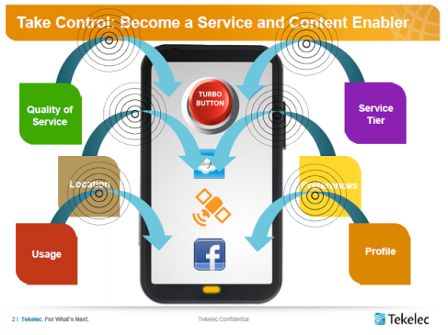Given the commotion around things that sizzle at the recent Mobile World Congress (MWC) in Barcelona, you may have missed a critical revelation. It is not a subject considered sexy but it should be. Tekelec detailed its vision for a new Diameter Network and key customer wins. What’s Diameter signaling? Why is this important? Let’s take a look.
Background: the coming tsunamis
Diameter signaling is the lingua franca of mobile network operation. Think of it as being to mobile networking what signaling system #7 (SS7) was for the wired voice TDM, 2G and 3G mobile networks. Tekelec’s vision for a New Diameter Network, is that it will/must be the foundation for successful next generation (4G, LTE and IMS-based), IP end-to-end mobile networks. The operative word is SUCCESSFUL. We in the industry are worn out by warnings of the impending tsunami of data traffic. We get it.
Mobile operators face threats to network performance, customer loyalty and profitability models. Yes, we know mobile operators felt the earthquake and heard tsunami warnings. We also know they are addressing concerns about network capacity by migrating to LTE, offloading traffic to Wi-Fi, and deploying small cells.
Unfortunately, what has gone largely unreported is the equally significant second tsunami (Tekelec calls it a “storm”) of network signaling traffic. It is as, if not more, critical than the first. It is centered around the fact that signaling traffic on mobile data networks is growing 30 – 50 percent faster than the data traffic it is enabling and managing. The causes are: the cumulative impact of device and application growth, personalized service plans, and an increasingly large and mobile subscriber base.
There is consensus that Diameter signaling is how network traffic will be managed, new services created, new business models effectuated, customers and their applications supplied differentiated experiences, personal and professional policies and rules enforced, etc. However, it needs to be on new and not legacy versions of Diameter. In needs to be one optimized for the all IP world.
The signaling tsunami impacts are not some distant problem. Recent network outages caused by network congestion that have prompted bandwidth throttling abound. Just this past week Verizon had significant issues with it 4G LTE network. Additional context is to understand that always on and open social networking apps like Facebook, gaming and other apps generate tons of signaling events every time this is a change of state. Plus, the mere act of battery reactivation has significant impact.
What does this mean going forward? As Diane Myers, directing analyst of VoIP and IMS at Infonetics Research, author of the just-released and first-ever report on the Diameter market, “Diameter Signaling Control Worldwide and Regional Market Size and Forecasts,” predicts, “As LTE networks expand, driving even more traffic to the network, the Diameter signaling controller market will take off rapidly: we forecast a 106 percent compound annual growth rate in vendor revenue through 2016, in line with global growth in LTE networks and LTE subscribers.” That’s a lot of growth and for good reason.
Note: It was just in 2011 that the Diameter signaling controller market has emerged as an important category. Hence the report and why the Tekelec vision for it commands attention.
The components of the New Diameter Network — what they are, where they fit and what they do
As the vision’s press release notes, the New Diameter Network provides three critical components:
- The Diameter Signaling Router (DSR): Relays messages with all Diameter-based network elements in 3G, IMS and LTE networks. The DSR establishes a connection with each endpoint, relieving them of routing, traffic management and load balancing tasks — shifting intelligence from the network edge to the Diameter core, improving network performance, reducing complexity, lowering costs, and enabling new services.
- The Policy Server (PCRF): Sts real-time business rules for managing network resources, prioritizing subscribers, applications and devices, and defining innovative services.
- The User Data Repository (UDR): Personalizes these rules with subscriber profile, state and usage data. The UDR is the central, real-time repository for front-end databases, such as Home Subscriber Servers (HSSs) and subscriber profile repositories (SPRs), storing location, authentication, preference, service, identity and presence data in one logical system.
Two diagrams illustrate what this means in terms of where the components fit in the network and at what layer. The first is important to understand because it shows the centrality of Diameter signaling control elements – policy servers, charging systems, subscriber databases, gateways, and session and mobility management equipment. These all rely on the Diameter protocol to exchange network, subscriber, policy, and charging information. Other sources of Diameter signaling include LTE subscriber authentication, LTE roaming, and subscribers who move between LTE and 3G or Wi-Fi networks.

In the world going forward, this means not just facilitating basic service but also more sophisticated ones. Tekelec for examples cites things such as personal ads, or shared data plans which track usage across multiple users and devices. These will exponentially increase signaling traffic.
Tekelec’s EAGLE XG middleware platform is the engine of the New Diameter Network, providing three essential layers of scalability:
- High message processing rates to handle spikes in signaling and data traffic
- Databases that scale to manage the immense volume of real-time subscriber and device data
- Diameter applications and use cases that can scale independently
In addition, the platform provides critical requirements such as geo-redundancy, congestion controls and overload protection to safeguard the network.
Where does the New Diameter Network fit? The figure below, while a bit of an eye chart, shows it well. IT is a dedicated Diameter control plane that puts service providers in the position to manage network resources and optimize subscriber services based on managing subscriber policies and profile data.

As Doug Suriano, Tekelec’s chief technology officer told MobilityTechzone, “The reality is that without Diameter signaling (specifically a formulation such as Tekelec’s vision) there could be no robust LTE. Every element in LTE network uses Diameter, security, monetization, etc. The network control layer eliminates point-to-point and meshed configurations and allows for the underlying 10X increase in traffic innate in LTE deployments as well as the extensibility to handle the explosion in signaling traffic all those smartphones and apps will generate.”
Suriano added that it was clear that as part of the effort to control network congestion, it was clear that operators around the world, as cited above, were going to have to move to usage plans along with Wi-Fi and small cell off loads, and that, “each one of these adds to signaling traffic.”
As noted at Barcelona, Tekelec announced five new customer wins for core component elements of its vision. What Suriano indicated was this not only brought the total to 12 publically announced wins but that the sense of urgency in the market meant there were dozens of operators expressing an intense interest. He noted that, “the race is on.”
This was a reference to the fact that certain operators were already throttling back heavy users, in major part because of the signaling problems associated with network congestion as a whole, but also because of the signaling load those heavy user placed on the network because of the apps they tend to run. He also noted for example that Verizon, who is a leader in its 4G LTE coverage, is facing 40 million phones coming off their plans in the next two years with the high likelihood that most of those 2G and 3G phones will be replaced by 4G ones, especially if, as expected, Apple starts retailing a 4G iPhone and the exploding tablet population starts straining Wi-Fi and mobile hotspot resources.
Who says plumbing isn’t sexy?
Edited by
Jennifer Russell  QUICK LINKS
QUICK LINKS